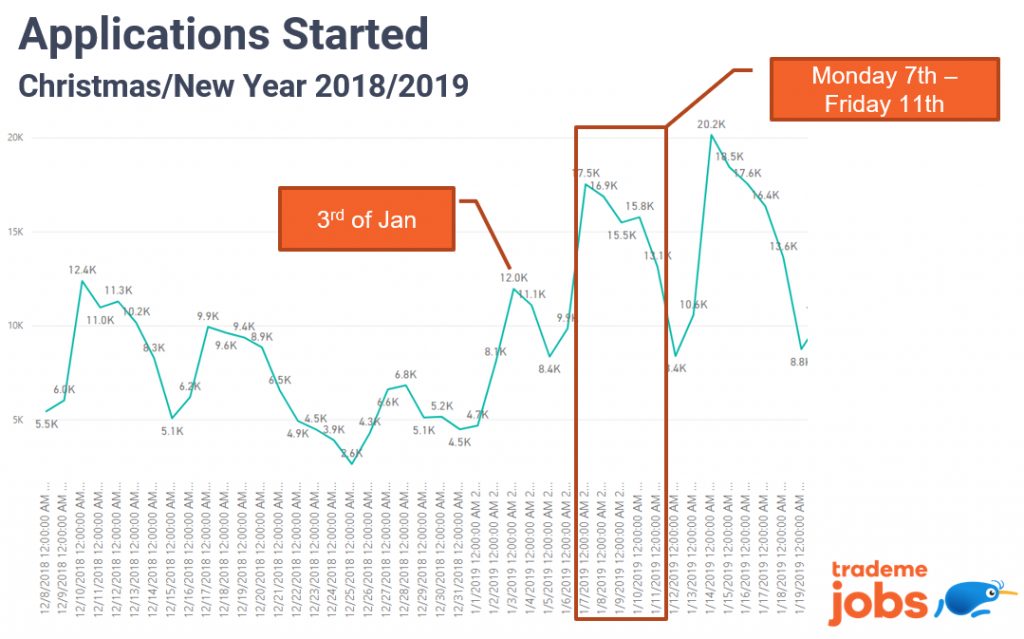In this edition:
- Remuneration threshold changes
- Introducing expat resettlement expert, Bridget Romanes
- 2020 investment outlook
- Job hunting and job advertisements during December and January
- No Xmas cheer: BNZ – BusinessNZ performance of manufacturing index
Remuneration threshold changes
With February fast approaching, it is important to pay regard to Immigration New Zealand’s upcoming remuneration changes. As of the 24 February 2020, wage and salary thresholds are increasing for those wishing to obtain either a Skilled Migrant Resident Visa or an Essential Skills Work Visas.
This change comes as a result of Immigration New Zealand’s annual review of remuneration thresholds, and reflects their finding that the median New Zealand wage and salaries have increased by two percent in the last year.
With such changes, those on current visas have no need to worry. The forthcoming changes will not impact visas which have been approved and there is a lenient transition period. For instance, persons applying under the Skilled Migrant Residence Visa category are able to do so under the old threshold as long as their expression of interest (EOI) is selected before the 24 February 2020. Likewise, a transition period applies to the Essential Skills Work Visa; as long as an application is received by Immigration New Zealand before the 24 February 2020, the old threshold applies. However, it must be noted that applications for a further visa may result in different visa conditions if an applicant’s remuneration no longer falls within its original category.
Overall, the new threshold date is around the corner and therefore due consideration must be given to the upcoming changes. The changes can best be summarised under the following categories:
- Changes to Skilled Migrant Residence Visa applications
ANZSCO level one to three occupations:
- As of the 24 February 2020, applicants for ANZSCO level one to three occupations must be remunerated at least $25.50 per hour in order to receive points for skilled employment.
- Based on a 40 hour work week, this amounts to $53,040 per year.
- This is an increase of 50 cents per hour, up from the previous $25 per hour threshold.
ANZSCO level four and five occupations:
- Applicants for ANZSCO level four and five occupations must be remunerated at least $38.25 per hour in order to receive points for skilled employment.
- Based on a 40 hour work week, this amounts to $78,000 per year.
- This is an increase of 75 cents per hour, up from the previous $37.50 per hour threshold.
- It must be noted that there are some occupations which are exempt from this remuneration rate. Exempt occupations are able to receive skilled points for employment if they earn at least $25.50 per hour. Such occupations include but are not limited to a: child care worker, tour guide and logging plant operator. A comprehensive list of exempt occupations can be found online at Immigration New Zealand.
Pay rate to claim bonus points:
- Applicants must be remunerated at least $51 per hour in order to claim bonus points in an application.
- Based on a 40 hour work week, this amounts to $106,080 per year.
- This is an increase of $1 per hour, up from the previous $50 per hour threshold.
- Changes to Essential Skills Work Visa applications
Mid-skilled employment in an ANZSCO level one to three occupation:
- Applicants must be remunerated at least $21.68 per hour.
- Prior to this remuneration was required to be $21.25 or more per hour.
High-skilled employment, including ANZSCO levels four and five occupations:
- Applicants must be remunerated at least $38.25 per hour.
- Prior to this remuneration was required to be $37.50 or more per hour.
Lower-skilled employment, at any ANZSCO level:
- Applicants remunerated $21.67 or less per hour are considered lower-skilled.
- Prior to this, lower-skilled was considered to be remuneration of $21.24 or less per hour.
Lower-skilled employment in an ANZSCO level four or five occupation:
- Applicants remunerated $38.24 or less per hour are considered lower-skilled.
- Prior to this, lower-skilled was considered to be remuneration of $37.49 or less per hour.
- It must be noted that some ANZSCO level four and five occupations are exempt from this threshold and may be considered mid-skilled if they are remunerated $25.50 per hour. Such occupations include but are not limited to a: travel consultant, civil celebrant and a train driver. A comprehensive list of exempt occupations can be found online at Immigration New Zealand.
For further information or assistance with emigration please contact Lane Neave Lawyers on + 64 3 379 3720 or email liveinnewzealand@laneneave.co.nz
Introducing expat resettlement expert, Bridget Romanes
Lane Neave is introducing a new content section to our newsletter, curated and written by Expat Resettlement Expert Bridget Romanes, Principal of Mobile Relocation.
This material will take readers beyond the logistics of moving to New Zealand into how to build a new life here, and a long term future for them and their families.
Over the coming months we will look at subjects such as navigating the New Zealand housing market, finding the ‘right’ schools and preparing for the well-researched mental health/wellbeing challenges associated with moving countries.
This month we look at how to help kids make a successful move to New Zealand.
Exposing your kids to a different culture during their formative years is an amazing gift. These young people can develop super powers in terms of flexible thinking and interpersonal skills.
You’ll be creating what’s known as a Third Culture Kid (TCK) – Barack Obama is one of these!
But they can also experience elevated stress levels and a fragmented sense of belonging.
Managing this risk is an ongoing process, but here are 3 strategies to use pre-departure, and to re-visit as you settle into life in New Zealand:
1. Be cultural detectives as a family.
Help your kids be positive and curious about New Zealand, rather than shocked by differences because they arrive unprepared. The first step is to talk about your home country culture – what are the celebrations, how to people dress and eat, what type of behaviour is acceptable, what do people do with their leisure time.
Then introduce some discussion about what might be different about life in New Zealand. For example a summer Christmas means some unique ways of celebrating.
2. Mindful goodbyes build your kids’ resilience.
Make time, and organise events where appropriate, to farewell people, places and even pets. Feeling sad about leaving, or any transitions, is normal and it helps to create a positive memory alongside.
My daughter left the only home she had ever known, in Singapore, at the age of 4. She narrated a farewell tour while I filmed a movie of the garden and house. It’s become a treasured item which she now watches with a feeling of gratefulness. She’s learned that a painful situation can change over time, rather than being stuck in the negative emotion of un-marked departure.
3. Supercharge your bond with your child.
At least initially, their sense of belonging will rest on the family unit. Spend a fun evening together asking each other this list of questions to build up a profile of each family member.
- What makes you really angry?
- Who’s your best friend?
- Who’s your hero?
- What it you’re the best thing we do together as a family?
- What is your biggest fear?
- What’s your favourite food, book, music, colour, video game?
- Etc
Deep diving into this exercise gives a double return. Your child will really feel listened to. Plus, when the going gets tough with the stresses of adjusting to new schools and setting up a new life, you’ll have this information in your toolbox to bring kids and parents back together again.
Time for a favourite family activity anyone?
Article provided by Bridget Romanes – Principal, Mobile Relocation.
2020 investment outlook
After the turbulent ride of 2018, 2019 turned out to be a very good year for both equity and bond markets. At the beginning of 2019, I suggested that the odds of an imminent recession were low, and as a result, there was no need for investors to transition from equity to cash and bonds. My view has not changed for 2020. Investors should remain invested in the NZ market.
Financial markets more broadly are benefitting from an economic growth cycle that still appears to have legs and could even accelerate modestly this year. One key reason for that is the actions of central banks, which over 2019, made a concerted effort to deliver more policy stimulus. Despite labour markets generally being strong, central banks have been able to provide this stimulus because inflation has remained contained. In fact, there is an argument that inflation is now structurally lower due to the impact of technology and globalisation. Now it is fair to say that with interest rates already at historically low levels, central banks’ ability to continue to provide stimulus is becoming more limited. But encouragingly, many governments (including in New Zealand) are now looking to increase fiscal spending over the coming years, which should also help fuel economic growth going forward.
New Zealand is an open economy. Export performance, investment inflows and migrant-led population growth are three key pillars that have helped the New Zealand economy perform relatively well over recent years. All three factors are likely to continue to play an important role in 2020. And while the economy is still growing, the risk of many listed corporates failing remains low.
A key thing to watch this year will be politics. Both the US and NZ have elections this year. Economic policies, the expectations of election outcomes and actual outcomes are likely to lead to share market volatility (both here and abroad) during the year.
So how to invest for those new to New Zealand? The most realistic approach is to invest through multiple tranches, which is often the most cost effective. Trying to accurately time both dips in the currency and/or share market is extremely difficult.
Most investors tend to have a target FX rate in mind before investing and wait for it patiently. If that target rate is reasonable and investors are open to a close range around that target, this tactic can pay off.
That said, there can be a drawback of this tactic for some investors, especially those with a specific time constraint, e.g. investment with a deadline set by Immigration NZ, in that while they wait for their target FX rate to be achieved, they could miss out on potential share market returns. In that regard, we feel the multiple tranche strategy to new investments is generally the best approach.
Article provided by Ally Cui – Director, JB Were.
Job hunting and job advertisements during December and January
As people start to think about and new roles, we thought it would be valuable to share some insight into New Zealand job hunting and advertising behaviours traditionally across the December and January period from Trademe Jobs.
December
In December 2018 Trademe jobs had over $237k job ad applications. As you’d expect, there was a bit of a drop off in applications across the days around Christmas but from November 2018 to December 2018 they only saw a 23% decrease in job ad views overall.
The New Year wave
We see a spike in applications at the beginning of the New Year (after a few New Year Resolutions).
The graph below shows the application volume by day across Christmas/New Year 2018/2019.
We saw a spike on the 3 January (a Thursday) and another spike across the following Monday to Friday.
If the pattern follows true across 2019/2020 then we will see a spike on Friday 3 January and another spike Monday 6 to Friday 10 January.
In short, candidates continue searching and applying for jobs over the festive season. However, listings usually drop at this time of and then grow steeply as decision makers return to work – ie from here on in.
Enterprise Recruitment
Enterprise Recruitment have over forty years’ experience in the New Zealand market place and have strong networks throughout the country. We offer a complimentary CV review and feedback on your employability in the New Zealand market.
We can be contacted via Steve Baker on +64 27 212 5483 or steve.baker@enterprise.co.nz
No Xmas cheer: BNZ – BusinessNZ performance of manufacturing index
New Zealand’s manufacturing sector fell back into contraction for the last month of 2019, according to the latest BNZ – BusinessNZ Performance of Manufacturing Index (PMI).
The seasonally adjusted PMI for December was 49.3 (a PMI reading above 50.0 indicates that manufacturing is generally expanding; below 50.0 that it is
declining). This was a second consecutive decrease in activity, and the lowest result since September.
BusinessNZ’s executive director for manufacturing Catherine Beard said that the contraction experienced in December was symptomatic of how 2019 played out for the sector.
“The manufacturing sector averaged 50.9 over 2019, compared with 53.8 for 2018 and 56.2 for 2017.
While the first half of the year managed to just keep its head above water, the second half saw four of the
six months in contraction.
“Looking at the sub-index values for 2019, the key results for production and new orders averaged 50.1
and 51.7 respectively. Employment struggled to gain traction, averaging 49.4 over 2019. At this stage
there is not much evidence to suggest the first half of 2020 will see a noticeable improvement.
BNZ Senior Economist, Craig Ebert said that “the December result was disappointing. After a couple of
months flirting with positivity, the PMI dipped back just below the breakeven line again”.
Article reproduced with the permission of the BNZ.
Open your account with Bank of New Zealand up to 12 months before you arrive. To find out more visit:








